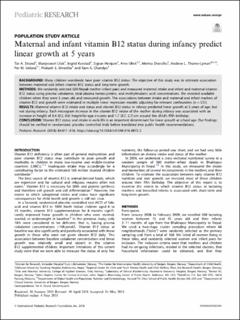| dc.contributor.author | Strand, Tor A | |
| dc.contributor.author | Ulak, Manjeswori | |
| dc.contributor.author | Kvestad, Ingrid | |
| dc.contributor.author | Henjum, Sigrun | |
| dc.contributor.author | Ulvik, Arve | |
| dc.contributor.author | Shrestha, Merina | |
| dc.contributor.author | Thorne-Lyman, Andrew L | |
| dc.contributor.author | Ueland, Per Magne | |
| dc.contributor.author | Shrestha, Prakash Sunder | |
| dc.contributor.author | Chandyo, Ram Krishna | |
| dc.coverage.spatial | Norway | en_US |
| dc.date.accessioned | 2022-11-25T13:15:05Z | |
| dc.date.available | 2022-11-25T13:15:05Z | |
| dc.date.created | 2018-08-03T21:38:29Z | |
| dc.date.issued | 2018 | |
| dc.identifier.citation | Pediatric Research. 2018, 84 611-618. | en_US |
| dc.identifier.issn | 0031-3998 | |
| dc.identifier.uri | https://hdl.handle.net/11250/3034133 | |
| dc.description.abstract | BACKGROUND:
Many children worldwide have poor vitamin B12 status. The objective of this study was to estimate association between maternal and infant vitamin B12 status and long-term growth.
METHODS:
We randomly selected 500 Nepali mother-infant pairs and measured maternal intake and infant and maternal vitamin B12 status using plasma cobalamin, total plasma homocysteine, and methylmalonic acid concentrations. We revisited available children when they were 5 years old and measured growth. The associations between intake and maternal and infant markers of vitamin B12 and growth were estimated in multiple linear regression models adjusting for relevant confounders (n = 331).
RESULTS:
Maternal vitamin B12 intake and status and vitamin B12 status in infancy predicted linear growth at 5 years of age, but not during infancy. Each microgram increase in the vitamin B12 intake of the mother during infancy was associated with an increase in height of 0.4 (0.2, 0.6) height-for-age z-scores and 1.7 (0.7, 2.7) cm around the child's fifth birthday.
CONCLUSION:
Vitamin B12 status and intake in early life is an important determinant for linear growth at school age. Our findings should be verified in randomized, placebo controlled trials before translated into public health recommendations. | en_US |
| dc.description.sponsorship | We are grateful for the contributions of the field supervisor Chandrawati Chitrakar and data managers Pravin Rajbhandari and Uma Regmi, and the children and mothers for their invaluable contribution to the study. The present study was funded through grants from the Research Council of Norway (project no. 234495), from the GCRieber Funds, and the South-Eastern Norway Regional Health Authority (grant no. 2012090). | en_US |
| dc.language.iso | eng | en_US |
| dc.publisher | Springer Nature | en_US |
| dc.rights | Navngivelse-Ikkekommersiell-DelPåSammeVilkår 4.0 Internasjonal | * |
| dc.rights.uri | http://creativecommons.org/licenses/by-nc-sa/4.0/deed.no | * |
| dc.title | Maternal and infant vitamin B12 status during infancy predict linear growth at 5 years | en_US |
| dc.type | Peer reviewed | en_US |
| dc.type | Journal article | en_US |
| dc.description.version | publishedVersion | en_US |
| dc.rights.holder | Springer Nature | en_US |
| dc.source.pagenumber | 611-618 | en_US |
| dc.source.volume | 84 | en_US |
| dc.source.journal | Pediatric Research | en_US |
| dc.source.issue | 5 | en_US |
| dc.identifier.doi | 10.1038/s41390-018-0072-2 | |
| dc.identifier.cristin | 1599735 | |
| dc.relation.project | Norges forskningsråd: 234495 | en_US |
| cristin.unitcode | 1991,1,2,0 | |
| cristin.unitname | Avd Forskning | |
| cristin.ispublished | true | |
| cristin.fulltext | original | |
| cristin.qualitycode | 2 | |

